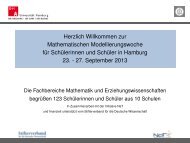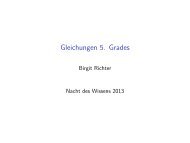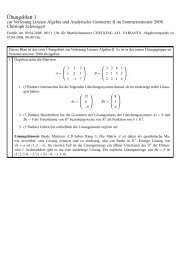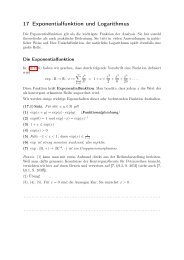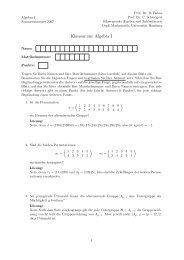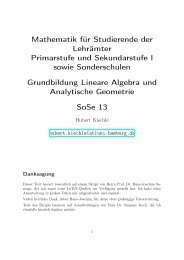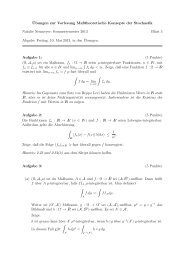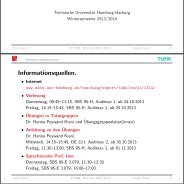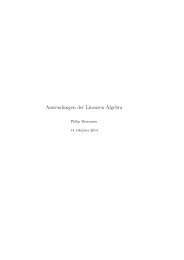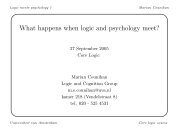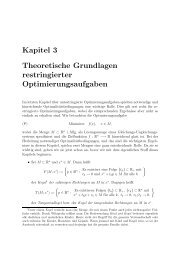pdf file
pdf file
pdf file
Create successful ePaper yourself
Turn your PDF publications into a flip-book with our unique Google optimized e-Paper software.
The structure of three-dimensional topological field theories is much more involved. Here,<br />
the notion of a Hopf algebra will enter, as we will see later.<br />
Before turning to this, we consider a generalization and a specific construction:<br />
Example 4.1.13 (Open/closed topological field Theories in dimension 2).<br />
• We define a larger category Cob(2) o/cl of open-closed cobordisms:<br />
– Objects are compact oriented 1-manifolds which are allowed to have boundaries.<br />
These are disjoint unions of oriented intervals and oriented circles.<br />
– As a bordism B : M → N, we consider a smooth oriented two-dimensional manifold<br />
B, together with an orientation preserving smooth map<br />
φ B :<br />
M ∐ N → ∂B<br />
which is a diffeomorphism to its image. The map is not required to be surjective.<br />
In particular, we have parametrized and unparametrized intervals on the boundary<br />
circles of M. The unparametrized intervals are also called free boundaries and constitute<br />
physical boundaries. The other boundaries are cut-and-paste boundaries and<br />
implement (aspects of) locality of the topological field theory.<br />
Two bordisms B, B ′ give the same morphism, if there is an orientation-preserving<br />
diffeomorphism φ : B → B ′ such that the following diagram commutes:<br />
B <br />
φ<br />
B ′<br />
φ B<br />
M ∐ φ ′ B<br />
N<br />
Thus the diffeomorphism respects parametrizations of intervals on boundary circles<br />
and parametrizations of whole boundary circles.<br />
– For any object M, the identity morphism id M is represented by the cylinder over M.<br />
– Composition is again by gluing.<br />
• Again, disjoint union endows Cob(2) o/cl with the structure of a symmetric monodial<br />
category with the empty set as the tensor unit.<br />
• An open-closed TFT is defined as a symmetric monoidal functor<br />
Z : Cob(2) o/cl → vect(K) .<br />
Again C := Z(S 1 ) is a commutative Frobenius algebra. One can again write generators<br />
and relations for the cobordism category and finds that the image O := Z(I) of the<br />
interval I carries the structure of a Frobenius algebra. C is called the bulk Frobenius<br />
algebra, O the boundary Frobenius algebra.<br />
• The Frobenius algebra O is not necessarily commutative: given three disjoint intervals<br />
on the boundary of a disk, two of them cannot be exchanged by a diffeomorphism of the<br />
disc. This situation is thus rather different from three boundary circles in a sphere, where<br />
two of them can be continuously commuted. For this reason, the bulk Frobenius algebra<br />
C is commutative.<br />
Still, the boundary Frobenius algebra is symmetric, i.e. the bilinear form κ 0 : O ⊗ O → K<br />
is symmetric: κ O (a, b) = κ O (b, a), as is shown graphically by cyclically exchanging two<br />
parametrized intervals on the boundary of a disc.<br />
89




